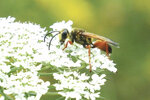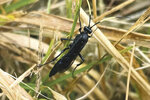

It is a joy to come across a wasp like this. In the matted thick grass where my pasture will flood in winter, it dances along the stalks, wings flashing, blue-black body orienting this way and that. Its antennae, curved outward, have matching bands of yellow near the base, the only bright color on the wasp, and they vibrate like tuning forks as it moves. It climbs to the top of a stalk and senses the air.
I do not recognize it. That’s not unusual when it comes to wasps. When we think about biodiversity, the matrix of living things that make up our corner of the natural world, wasps ought to be the poster child.
Beetles have long been celebrated as the most diverse insect order. You’ll hear that one in four species on Earth is a beetle. Scientist J.B.S. Haldane, when asked what could be learned of the Creator from the study of nature, famously quipped, “An inordinate fondness for beetles.” Yet a growing number of entomologists argue that there are more types of wasps than beetles.
At one end of the pasture is a nest of yellow jackets in a rotten gate post. I was stung in the nose and shoulder trying to open the gate. At the other end of the pasture, near my garden, is a volleyball-sized nest of bald-faced hornets. I knocked their first nest off my garden shed and now watch this elaborate pulp chandelier grow from wood and saliva.
Wasps like these get our attention. They should. Their societies are impressive. But the vast majority of wasps have neither a social lifestyle nor the need to defend it with stings. Many are tiny. Most are solitary.
The pasture wasp, I later find, is in the genus Coelichneumon. No common name. Nothing published on its life history. So much of our local ecosystems remains unknown. It is in the ichneumon wasp family, a family with more species than there are bird and mammal species in the world. Ichneumons tend to parasitize caterpillars.
That’s a start. But the odds of learning the details are remote. Many wasps are specialized to a degree that stretches belief. Take a moth. For each of its life stages, wasps are there. Some wasp larvae eat moth eggs. Others live inside the egg, let it hatch, and eat the caterpillar. Many wasps lay their eggs straight into caterpillars, some killing them, others allowing them to live, some emerging as adult wasps from the caterpillars, others waiting and emerging from the moth pupae. Often wasps carry special viruses to help predigest the host or cause it to perform strange zombie-like behaviors. There are thousands of moth species in our area. How many wasp species?
Wasps like ichneumons partition resources. Take a plant. Some wasp larvae chew leaves, others bore into stems or wood, and others form galls. Many adult wasps eat nectar and feed their young with pollen. Others dance across the surface of wood, listening for wood-boring beetle larvae inside and using ridiculous long ovipositors to bore through the wood and lay an egg on the grub hidden inside.
Hyperparasitoid wasps parasitize the parasites. One wasp family does it like this: The adult wasp lays hundreds of tiny eggs on a leaf. If a caterpillar eats the eggs, the eggs hatch into larvae inside. They only start feeding if another parasitic larva is inside the caterpillar. Another family requires its host caterpillar to be killed by social wasps and taken to their nest, where, while the social wasps dismantle the caterpillar, it emerges to feed as a parasite on the social wasp’s larvae.
Talk about a strange world. You might see spider wasps, grass-carrying wasps, sand wasps, great golden digger wasps, potter wasps. I like gall wasps. They don’t just exploit existing spaces; they tap into a plant’s latent potential to grow new spaces. Recently, in a patch of baldhip rose, I found galls looking like cushiony sea urchins, tan with pink spikes, from a minuscule wasp named Diplolepis polita.
Gall-makers stab their eggs into a plant. The plant responds by swelling in distinctive and often decorative ways: galls. These are protective chambers in which the gall-maker’s larva can hatch and eat in safety. Well, what would be safety if there weren’t always more wasp species looking for any inch of space. Ninety percent of Diplolepis polita galls are host to inquilines — other larvae that have been deposited in the gall — or parasitoids that are there not just for the gall but for the Diplolepis larva. Each gall is an ecosystem. Oaks are famous for their abundant and diverse galls. Willows too.
So, are wasps beneficial? Such a question betrays a simplistic sense of the diversity around us. Consider the multitude of wasp lifestyles. Sure, most wasps are beneficial as pollinators and pest control. Others, like nonnative yellowjackets and paper wasps, take far more than they give.
But taking a step back, wasps seem to exist purely to compound the complexity of an ecosystem. I like to think of wasps, and diversity, in terms of flows of energy. After sunlight becomes plant tissue, where does it travel? Wasps home in on all points of a food web, stealing and redistributing, looping the flows of energy with the complex stitches of master weavers.
If there are many routes for energy to travel, you have a strong ecosystem. In our neck of the woods, diversity runs deep. Keep an eye out for wasps.
UNDERWRITTEN BY THE FUND FOR NONPROFIT NEWS (NEWSMATCH) AT THE MIAMI FOUNDATION, THE ANGEL GUILD, ADVERTISERS, DONORS AND PEOPLE WHO SUPPORT INDEPENDENT, NONPROFIT LOCAL NEWS